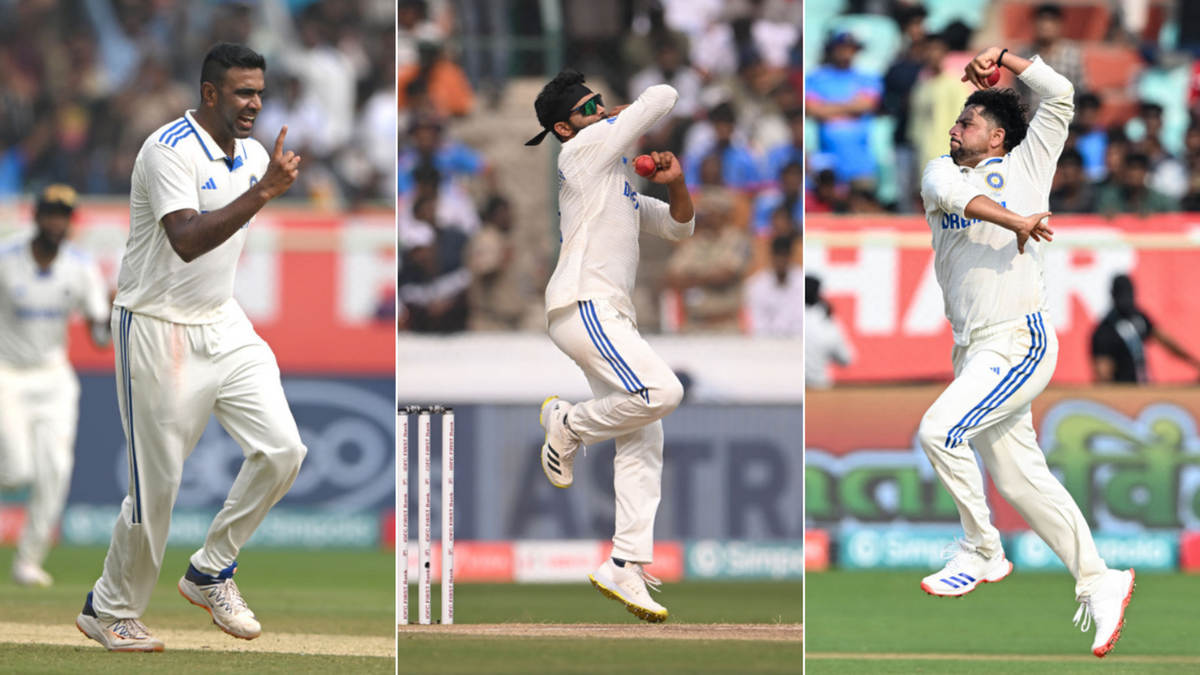
As India gear up for the third Test against England at Rajkot, they have a decision to make regarding the makeup of their spin attack – here’s a lowdown of all the options they have and the pros and cons of each.
Subscribe to the Wisden Cricket YouTube channel for post-match analysis, player interviews, and much more.
Ravindra Jadeja’s injury in the second Test meant Kuldeep Yadav got an opportunity. His left-arm wrist spin provided variety and an air of mystery, as he ended up picking up four wickets in the match. As Jadeja is set to return on his home ground, India are faced with a difficult question – which spinner to leave out? In fact, if they are feeling adventurous, India also have the option of not leaving any out and going all in with four spinners in the XI.
Here’s a calculation of the merits and demerits of each option India have.
Ashwin, Jadeja, Axar, Kuldeep – four spinners, all in
From the two Test matches which Rajkot has hosted, spinners have averaged 37, while seamers have taken wickets at 58 apiece. India have gone in with a combination of three spinners and two seamers in the first two Tests of the series, but the second seamer has not had much to do, giving rise to temptation of fielding four spinners instead. With Jasprit Bumrah proving unplayable in the series so far, India can afford to think in that direction.
However, it’s important to be realistic with the idea of playing four spinners. Even with three in the XI, one of them often gets under-bowled. With four, that is bound to happen as managing and rotating them might prove difficult, particularly given how spinners operate in long spells.
R Ashwin needs one more wicket to become only the second Indian bowler with 500 wickets!
What a journey. 🔥#INDvsENG pic.twitter.com/jEB5k5WTVr
— Wisden India (@WisdenIndia) February 13, 2024
On the flipside, having four spinners will give India the privilege of not letting English batters line up and take down one particular bowler. Jadeja and Axar are the only ones with the same bowling categorisation, left arm orthodox. But their bowling styles are vastly different, giving India the luxury of extreme variety in the attack which would help them adapt to England’s unique methods on the go. With all spinners being handy (or more than that) with the bat, this combination will also lengthen India’s batting order.
The pitch for the Rajkot Test, however, does not bear as dry a look as it usually does. England have named two seamers in their XI in this series for the first time as well. Unless India are convinced that the surface will turn big and turn soon, chances are slim that they will go in with four spinners.
Jadeja in for Kuldeep
The easiest swap India could do is to bring back Jadeja in place of Kuldeep to restore the combination that played in the first Test of the series in Hyderabad. However, Kuldeep’s variety is an advantage that India would want to utilise more of, particularly given the ultra-attacking instincts of the English batters.
Moreover, the wrist-spinner bowled 32 overs in the second Test, most among all Indian spinners in that game, indicating the kind of faith the captain has in him. While Jadeja will be provide a major upgrade on Kuldeep the batter, the latter’s unique skills with the ball make him too valuable an asset to be dropped.
Axar out, Jadeja in
The other option India have is to make a straight swap between Axar and Jadeja. Axar has not been at his best with the ball in this series, having taken only five wickets from four innings at 41.20 runs per wicket. In the Vizag Test, he was targeted from the get go, forcing Rohit Sharma to bowl him for just four overs in the first innings, where he conceded at six runs per over. In the second innings as well, Axar bowled the least number of overs among the three spinners and went at 5.35 rpo, the most expensive of all.
Axar batted at No.6 in the second Test in Jadeja’s absence, which would make it easy to swap him out without disturbing the batting order. But his batting contributions will make it a difficult call for the management. Axar made 27 and 45 in the second Test, following up contributions of 44 and 17 in the first.
Axar Patel has scored 397 runs in his last ten Test innings.
India batters with the best batting average in this period (min. 100 runs):
Yashasvi Jaiswal: 637 @ 57.90
Axar Patel: 397 @ 56.71
Virat Kohli: 729 @ 52.07#INDvsAUS pic.twitter.com/oCeJ066UWL— Wisden India (@WisdenIndia) February 13, 2024
However, if India managed to pull off a comprehensive victory with Axar at six, Ashwin at eight, and Kuldeep at nine in Vizag, there’s no reason why they can’t repeat it with Jadeja, an equally if not more reliable option with the bat, in place of Axar.
Can Ashwin sit out? Any scope for Sundar, Sourabh?
Ashwin has not missed a single home Test since his debut and that fact that does not seem to be changing any time soon. Washington Sundar and Sourabh Kumar are also in the squad, but with the four first-choice spinners all available for selection, they don’t have much of a realistic chance to make it to the final XI.
Which spinner should India pick for the Rajkot Test – Washington Sundar or Kuldeep Yadav? #INDvsENG pic.twitter.com/cmrCCzfz4Q
— Wisden India (@WisdenIndia) February 13, 2024
Sundar might still make it primarily as a batter, given India have to fill in the hole left by the dropping of Shreyas Iyer. But with Sarfaraz Khan waiting in the wings for a much-awaited Test debut, Sundar might have to wait a bit longer.








